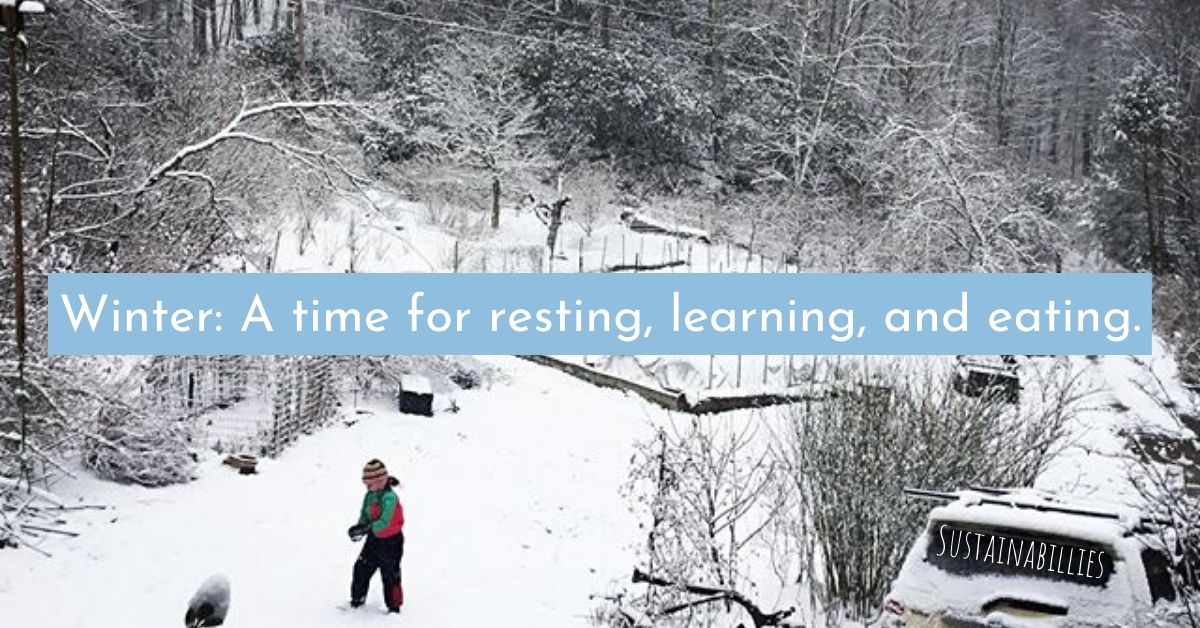Winter. This is the time of year for resting, learning, and eating.
There is a ton of good food that needs to be consumed. We are burning a lot more calories when we do work around the farm keeping warm. Having jars of home canned food in the can room is one of the most joyous things that a person can experience in winter. We just walk downstairs and open a door to our own private organic grocery store.
Cans of beans, tomatoes, pickles, sauces, jellies, syrups, chilies, salsas, soups, ciders, and more grace the walls in our basement. Freezers full of meat from a 2 year old Scottish Highland cow we saw grow up and a hog named Ruby that was grown for us by our friends in KY.
Winter is the time for building brains and spirits.
Getting fat is not just about jeans getting a little tighter. The scale reflecting 10 pounds of pure joy that have crossed your lips over the holiday season. It is not just about getting to read and watch movies, cuddling and fire hovering the woodstove while you slow cook a roast in a Dutch oven.
Knowing that spring and summer are on the way, with greens fresh from the garden and grazing all day on fruit gives you the resolve to follow the rhythms of natural food consumption.
We eat how our bodies tell us to, and stay strong and healthy by staying active on the farm all year.
Cooking with the season means that you really do eat very different foods at different times of the year. It is an adjustment to not eat fresh strawberries in January and apples in May. We do eat frozen berries all year in our smoothies, pies, and other baked goods. Anytime we get the craving for sunshine in a jar, apple sauce and canned cider are sure to please.
In winter you eat a lot of meat, winter squash, eggs, canned foods and frozen foods. We still cook diverse and delicious meals.
The tomatoes are in a jar and the peppers are frozen. The sauces are homemade and the beef is lean, local, and flavorful. If it has been warm we get a sweet treat of shiitakes that can flush all winter. They bring something fresh to the table.
Many meals incorporate greens of some kind. Kale, mustards, and chard will persevere through winter in the garden.
Cooking with the season also means that you get to take advantage of fire. We cook foods in Dutch ovens and pots directly on top of our big woodstove downstairs. We slow cook stuff all day when it is a small fire and can quickly boil a pot when it is super cold outside.
You do need to determine what to cook based on how hot your fire is, which correlates to how cold it is outside. Chilies and thick soups are better for low temps and thin soups and roasts in liquid are better for hotter fires.
We also have a wood fired cook stove in the kitchen that heats the house and cooks dinner at the same time. We try to only use the electric stove if it is too warm to burn a fire.
Winter is also the time for planning.
Looking at what we grew last year and determining what seeds to order and in what quantity. We are starting the adventure of hosting a CSA on our property, and hope to grow enough food for 4-5 boxes of produce each week. This will require us to plan much more intensively for the next growing season.
We are also gearing up in the shop. Making tools, art, and things we need for the farm. Cleaning, straightening, and sharpening tools and our minds until the weather gets warmer again.
Here is to wishing you a good eating season and sweet dreams of sprouting plants and spring wildflowers.


